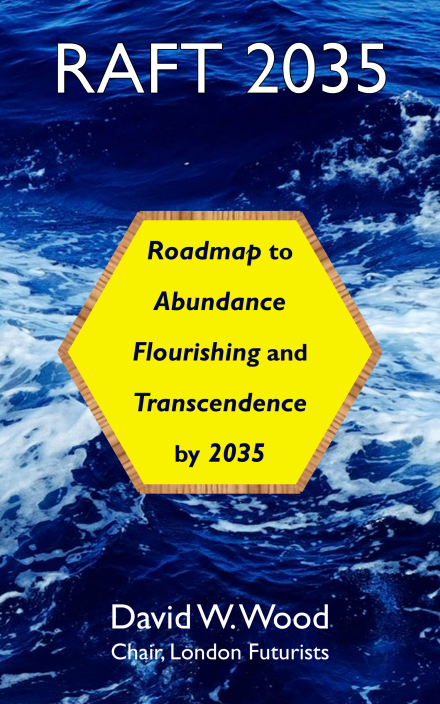This page contains the opening portion of Chapter 9 from
Sustainable Superabundance: A universal transhumanist invitation

9. Towards abundant intelligence
The sustainable superabundance that potentially lies ahead involves more than just a better environment – clean energy, nutritious food, and ample material goods (the subjects of earlier chapters). It involves more than just the radical enhancement of our bodily health (the subject of the previous chapter). Crucially, it also involves the radical enhancement of our brains, mind, and spirit. In other words, with the right choices and the right actions, we can look forward to a blossoming of all-round intelligence.
This intelligence will reside in three locations. First, our individual brains can be improved, and will work much better than before. Second, artificial intelligence, resident in all kinds of computing hardware, can jump upwards in capability. Third, the aggregate intelligence of whole societies of people can be upgraded, allowing groups to draw on collective insight to solve problems that would previously have defeated them.
None of this will take place automatically. Nor will increases in intelligence necessarily lead to beneficial scenarios, rather than to deadly scenarios. As with all the other spheres of abundance discussed in this Invitation, the actual outcome will depend critically on choices taken by humanity over the next few years.
A key complication is that merely becoming more intelligent is no guarantee that someone will become wiser. Far from it. Some of the world’s nastiest politicians are evidently highly intelligent; likewise some of the world’s most ruthless criminals. A given quantity of intelligence can be applied in service of any number of different goals – including destructive goals as well as constructive goals. Intelligence can be deployed to confuse and mislead – to cajole and bamboozle. Greater intelligence gives people greater ability to accomplish whatever objectives they have already decided to pursue – and greater ability to find clever justifications to promote those objectives.
Although we humans like to think of ourselves as rational beings, a better description in many cases is that we are rationalising beings. We are expert in finding reasons that support our preexisting choices. As modern online searches place more ever information at our disposal, the easier it becomes for us to discover special cases that appear to back up our own favourite worldviews. As we connect into ever wider online communities, the more we can come across people who seem to share our viewpoints, reassuring us that we are on the right lines. As for evidence that appears to contradict our views, and critics who disagree with us, the online world can provide us with ingenious reasons to disregard that evidence and critics.
True all-round intelligence will rise above such narrow intensity and blinkered reasoning. But reaching this level of intelligence will require a lot more than merely turbo-charging our existing modes of reasoning.
The rise of Artificial Intelligence
Intelligence can be defined as the ability to figure out how to accomplish goals. In simple environments with simple goals – for example, to win in a game of chess, or to find the quickest route between two locations on a map – the intelligence required is “narrow”. For more complex environments and more complex goals, intelligence needs more general capabilities.
Human intelligence involves being able to understand and predict the motion of both animate and inanimate objects. It involves the development of a “theory of mind” – an understanding of the factors that can motivate creatures with minds to change their own beliefs and behaviours. It involves the skill of breaking down a complex task into a series of subtasks. It involves being able to select and accumulate resources that could be of use at later stages. It involves the ability to collect more information, for example by designing and carrying out experiments, in order to make better decisions. It involves being able to learn from setbacks and surprises, rather than merely repeating the same actions over and over.
From the 1940s onward, various aspects of human intelligence have been duplicated in electronic computers – starting from code-breaking and the calculation of missile trajectories. Over the decades, so-called “expert systems” emerged, that could assist humans to carry out all kinds of different decisions.
In more recent times, a disruptive new wave of computer programs called “machine learning” has achieved surprising success, often dramatically surpassing the performance of expert systems. Machine learning software can in effect infer by itself the relationships between various sorts of input and output data. For example, to tell the difference between pictures of cats and pictures of dogs, an expert system would include large numbers of specific rules, entered individually by human programmers, along with information about exceptions to each rule. A machine learning system, in contrast, would be shown lots of pictures of cats and dogs, and would, via a process known as “training”, figure out a set of factors to distinguish the two cases.
Since the operation of successful machine learning involves numerous layers of simple binary decisions that have some elements in common with the on-off firing of neurons in the brain, the names “deep learning” and “neural networks” are commonly used.
Transhumanists anticipate that, just as expert systems have recently been overtaken in capability by the new wave of deep learning, so will deep learning be in turn overtaken in capability by yet new waves of artificial intelligence.
<snip>

